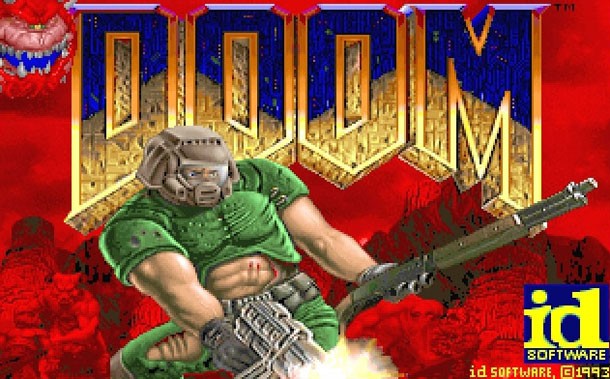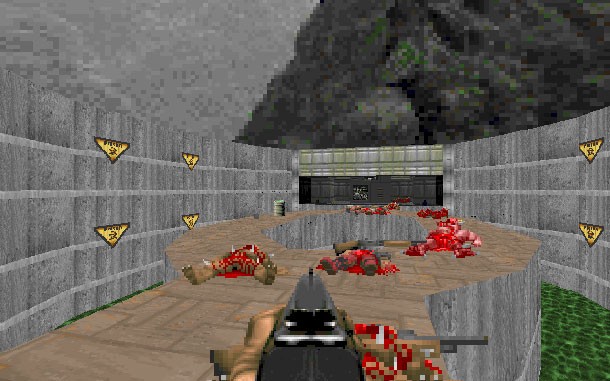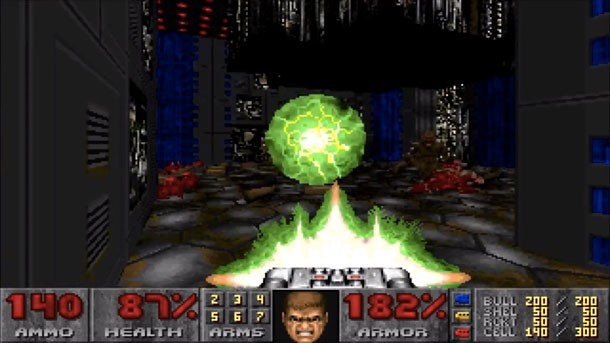Subscribe now to get the Ninja Gaiden 4 issue and a Phantom Blade Zero poster pack-in!
The Essentials – Doom

For over a month now, Game Informer has been taking a look back at the video game industry's most important titles. Dubbed the Essentials, these games aren't just a ton of fun: Their quality, innovation, and industry influence make them must-play experiences for anyone who wants a greater appreciation of our interactive medium.
This weekend we're taking a look at the game that cemented the popularity of the first-person shooter genre: Doom.
Release Year: 1993
Publisher: GT
Interactive
Developer: id
Software
Released For: PC,
Mac, Linux, Xbox 360, PlayStation 3, Atari Jaguar, Xbox, PlayStation, Sega
Saturn, Sega 32X, 3DO, Super Nintendo, GBA, iOS
While id Software kicked off the first-person shooter craze in 1992 with the release of Wolfenstein 3D, the pioneering title is often overlooked in favor of its horror-infused successor. Why? Doom's refined take on the burgeoning genre was the first to immerse players in a real sense of place, trading Wolfenstein's identical hallways and floating chandeliers for strange and atmospheric military compounds on Phobos.
Despite the limitations of computing power in 1993, industry visionaries John Carmack and John Romero loaded Doom with countless impressive technical advancements. Doom's levels featured variable lighting, moving objects, and non-perpendicular geometry, none of which were possible in Wolfenstein 3D. Suddenly, the action wasn't limited to a single plane – the terrain could rise and descend (we even got stairs!), and transition seamlessly from cramped corridors to pseudo-outdoor areas. Doom's sense of immersion sold players and game designers alike on the first-person genre.

Doom's level designers weren't trying to create realistic environments. Instead, gameplay was king.
Doom's enemy A.I. wasn't super advanced, but the gameplay was entirely skill-based; succeeding meant learning the behavior and attacks of each enemy type and being constantly on guard for visual and audio cues. Doom remains the definitive active shooter; harder difficulty levels require constant running, dodging, and shooting to stay alive. Don't expect any leveling up or convoluted cover mechanics to aid you in your survival. "Skill upgrades" in Doom are on you, and are achieved solely by getting better.
Each map in Doom was often the product of a single designer, and not beholden to real-life locations or architecture. This gave designers complete control and creative freedom to craft gameplay-centric maps and quickly reiterate on ideas in a way that large development teams rarely can. Sure, Doom levels may not have the photo-realistic visuals or scale of today's most popular FPS franchises, but they have personality along with a score of interesting tactical encounters, surprises, and secrets. A timer and "par" developer times on the end-of-level stat screens fostered competition among players to see who could beat levels the fastest, and the built-in ability to record demo playthroughs made Doom one of the first games to have a thriving speedrunning community – though you didn't have to be a speedrunner to find a ton of enjoyment in endlessly replaying the game.

Doom featured a number of memorable weapons including the iconic and notoriously named BFG9000.
Unsurprisingly, Doom served as a springboard for countless copycats, giving birth to the term "Doom clone." Hexen (made by Raven Software with the Doom engine), Dark Forces, Rise of the Triad, and Duke Nukem 3D all served up similar action with different motifs, but failed to gain anywhere near the same level of interest. As such, Doom was front and center in the video game violence debate. However, the popularity of Doom also undermined the argument made by so many concerned parents and politicians. If playing Doom made you violent, then everyone would be violent, because everyone was playing Doom.
Doom may not have inspired violence in kids, but it did inspire a generation of developers, many of whom started as amateur designers using the game's revolutionary "WAD" architecture to create and release their own levels. This includes BioShock level designer JP LeBreton, who sat down with John Romero to discuss Doom in a fascinating playthrough filmed by 2 Player Productions, which you can see below. The reverence and appreciation LeBreton has for Doom is shared by many in the industry, and with good reason.
Online multiplayer is just another example of Doom's sprawling web of innovation and influence; the game featured the very first FPS deathmatch mode, sparking a revolution in competitive play. Even if you've never played Doom's multiplayer, you sort-of have; virtually all modern multiplayer shooters are built on the backbone of Doom's prototypical deathmatches.
Doom is such a pivotal title for the video game industry that author David Kushner wrote an entire biography on the game and the people behind it. Reading Masters of Doom is highly recommended – but not as much as playing the game that shaped the industry's most popular genre. Thankfully, Doom is available on pretty much every platform known to man – a fact that should come as no surprise given how well the game has held up after all these years.
For more of the Essentials, click the banner below.










